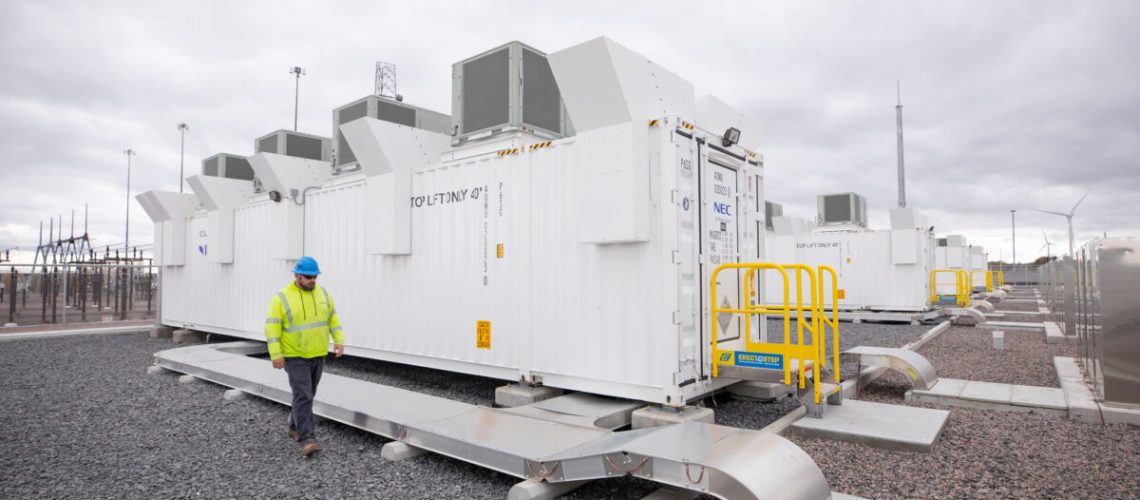The 20 MW utility-scale battery energy storage facility will help accelerate the target of 6 GW of energy storage by 2030.
The 20 MW Northern New York Energy Storage project installed and operated by the New York Power Authority connects into the state’s electric grid in Chateaugay, NY. It is the first utility-scale battery energy storage project in the state and the Power Authority’s first utility-scale battery project.
The storage plant consists of five 53-foot walk-in enclosures, each with more than 19,500 batteries grouped in modules and stacked in racks. Each container pulls in and can disperse 4 MW of power, enough to power roughly 3,000 homes. The system, constructed by O’Connell Electric Company of Victor, New York, includes a lithium-ion battery system, inverters, transformers, a control house and backup generator, connected to the Willis Substation. The facility will be maintained and operated by the St. Lawrence-Franklin D. Roosevelt Power Project.
The project is located in northern New York state, about 40 miles northwest of Plattsburgh. The region generates more than 80% of its electricity supply from renewable resources, including the Power Authority’s St. Lawrence-Franklin D. Roosevelt Power Project, which generates more than 800 MW of hydropower and more than 650 MW of wind generation.
“Deploying energy storage technologies make our power supply more reliable and resilient, further enabling New York to build a robust clean energy grid,” said Governor Hochul. “The completion of the Northern New York Energy Storage project marks an important step to reaching New York’s energy storage and climate goals.”
Earlier this year, New York state released a roadmap to deploy 4.7 GW of additional energy storage projects by 2030. The Empire State is seeking 3 GW of “bulk storage,” 1.5 GW of retail storage, and 200 MW of residential storage. The state’s modeling predicts that it will cost $0.46 per month per electricity bill to incentivize developers to deploy this capacity.
“This is a first-of-its-kind project for the Power Authority and with it we are breaking new ground as we actively help lead New York State’s decarbonization efforts,” said Justin E. Driscoll, president and CEO of New York Power Authority (NYPA). “By demonstrating large-scale battery development and operation, we are showing our ability to execute forward-thinking strategies and new technologies.”
While fires at energy storage facilities are rare, Governor Hochul announced the creation of a new Inter-Agency Fire Safety Working Group. The New York State Division of Homeland Security and Emergency Services Office of Fire Prevention and Control, New York State Energy Research and Development Authority (NYSERDA), New York State Department of Environmental Conservation, Department of Public Service, New York Power Authority, and the Department of State will lead the Working Group to independently examine energy storage facility fires and safety standards.
The decision to convene the Working Group was prompted after several lithium-based battery projects faced thermal issues in New York State this summer.
NYPA’s engineers were involved with the planning, development and permitting of the project and the project team met with local fire departments for training on the battery storage technology used at the facility. NYPA’s engineers have ensured that the Northern New York Energy Storage Project met all fire safety and permitting requirements.
As lithium-ion battery technology can suffer from fire-causing thermal runaway, NYPA is also testing other types of battery technology like advanced lithium-ion and zinc-air technologies. Earlier this month New York announced four demonstration projects to receive funding through NYSERDA’s Renewable Optimization and Energy Storage Innovation Program to test and scale different long-duration energy storage technology proposals.
NYSERDA’s initiatives are financed through the state’s ten-year, $6 billion Clean Energy Fund. An additional $8.15 million is available to support more applicable long-duration energy storage solutions and other complementary technologies yet to be commercialized.
Project submissions should advance develop or field-test hydrogen, electric, chemical, mechanical, or thermal-electric storage technologies that will address renewable integration challenges, including grid congestion hosting capacity constraints and siting in New York. The last day to submit a proposal is October 17 by 3 p.m. ET. For more details, visit NYSERDA’s website.



